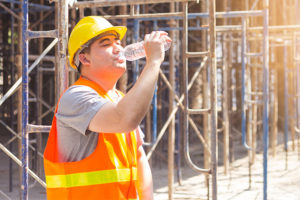May 10, 2024
Outdoor hazards to watch for during warm weather months
The end of any winter often brings a welcome reintroduction to the great outdoors.
You may not need to worry about hypothermia and other dangers of the cold, but warm weather is not without its own risks, especially for people who work outdoors. Depending on what kind of outdoor exposure you’re getting, there are a few warm-weather hazards to monitor.
Share the following tips with your employees to help them stay safe during warmer months.
Outdoor slips and falls
Icy sidewalks aren’t the only cause of falls when you’re outdoors — potential tripping and slipping hazards can happen all year long.
Pay attention to the conditions of the surfaces you’re walking on. Parking lots, sidewalks, ramps and stairs can all have cracks, holes or uneven surfaces that could cause you to trip. Use handrails on stairs or ramps, and try to keep your hands free of encumbrances. Do not carry more than you can handle or items that block your vision.
Don’t take shortcuts through lawns or center islands. Uneven ground and concealed or hard-to-see holes can result in twisted ankles or worse.
Also, summer months might have employees wearing different footwear than at other times of the year. Flip-flops, sandals, loose-fitting shoes, high heels, cowboy boots, etc., all increase the risk of slip and fall injuries or feet and ankle injuries. Employers need to mandate proper footwear and enforce it with workers.
Also, report any unsafe outdoor conditions to the appropriate person.
Heat stress
When you’re working in the heat, it’s important to make sure you stay hydrated. If you aren’t taking in enough fluids or salts, it can lead to heat-related illnesses, such as heat exhaustion or heatstroke.
To prevent heat-related stress, give yourself time to adjust to hot weather by limiting your exposure at first, and gradually increasing the amount of time until your body has acclimated to the heat. Try to schedule work during the coolest parts of the day.
Drink plenty of liquids to replace what your body loses through sweating. You should be drinking approximately one cup of water every 15 minutes. Sports drinks with electrolytes are useful for replacing necessary salts, as well.
Don’t ignore symptoms of heat stress. Stop your work to cool off in a shaded or air-conditioned area if you experience dizziness, nausea or muscle cramping.
These tips are especially important for workers in certain industries. In early 2024, the American Society of Safety Professionals published the first national voluntary consensus standard addressing heat stress for workers in construction and demolition operations.
At a high level, the document:
- Provides guidance on protecting workers
- Outlines how to acclimate workers to high heat conditions
- Gives tips for training employees and supervisors
The standard also contains checklists and flowcharts designed to help employers develop heat stress management programs.
Lightning safety
If you work outdoors, it’s important to pay attention to weather patterns. Thunderstorms are common across the country, and lighting safety is vital for employees who work outdoors.
From 2006 through 2021, there were 444 lightning strike fatalities in the U.S., according to the Centers for Disease Control and Prevention. Most of those deaths occurred in June, July or August.
Stay up to date on weather forecasts and watch out for early warning signs. If a storm is predicted, don’t start working on projects you won’t be able to stop quickly.
Clouds that grow vertically into towering cumulus clouds are often the first sign of a developing storm. Other indicators include high winds, dark clouds, rain and distant thunder.
When you see lightning, count the seconds until you hear thunder. If the time is 30 seconds or less, then the storm is close enough to be dangerous. Leave any open-air structures or areas with tall trees and seek shelter inside an enclosed building. Metal-topped vehicles are also safe.
If you are outdoors, stay off and away from tall structures or large equipment. Do not touch anything that can conduct electricity. Wait at least 30 minutes following the last clap of thunder before resuming your work.
Insect-borne diseases
Summer is peak season for ticks and insect bites. If you work outdoors, be aware of the conditions that put you most at risk. Insects are most active at dawn, dusk and early evening in tall grass, shrubs and wooded areas.
You can avoid insect bites by wearing long pants, sleeves, closed-toe shoes and a hat. Use insect repellents on clothes and exposed skin.
After being outdoors, you should perform body checks for ticks. If one is found, remove it immediately with fine-tipped tweezers by pulling it straight out. Then cleanse the area with antiseptic.
At the same time, illnesses such as Lyme disease and West Nile virus can be passed on by deer ticks and mosquitos. An estimated 476,000 people are diagnosed and treated for Lyme disease each year, according to the U.S. Department of Health and Human Services . And in 2023, more than 2,400 cases of West Nile virus were detected across 47 jurisdictions.
If you suspect you or one of your employees may have contracted an illness, seek medical attention right away.
Conclusion
Spring and summer months come with their own unique safety risks.
Getting back outside after a long winter can feel like a relief, but don’t let that cause you to let your guard down while working outside.
Lastly, federal officials have created a heat safety tool app employers can use as an additional resource.
Originally published in May 2019; updated May 2024.





